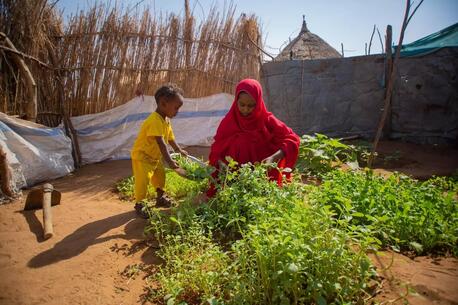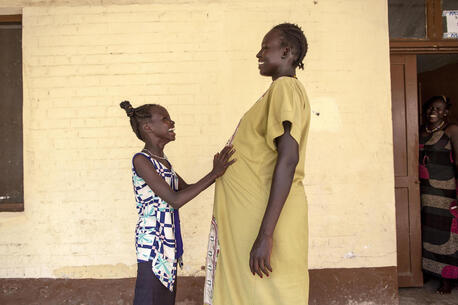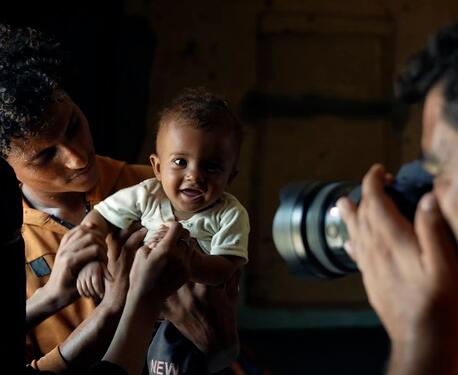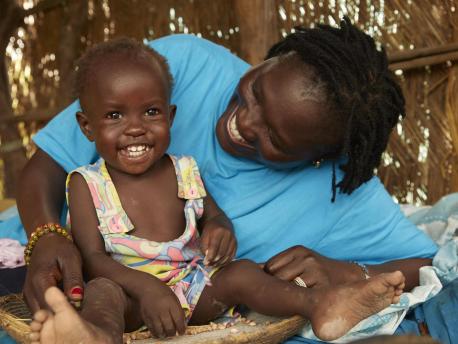
Helping Malnourished Babies Thrive in South Sudan
Babies suffering from severe acute malnutrition in South Sudan get a new lease on life thanks to UNICEF & Ready-to-Use Therapeutic Food.
Meet Akot, Adut and Amira, three babies who blossomed before my eyes, thanks to UNICEF nutrition specialists and Ready-to-Use Therapeutic Food.
Let's go back eight weeks, when I arrived in the town of Aweil in northern South Sudan to document how UNICEF is helping children suffering from severe acute malnutrition. Within hours of touching down, a videographer and I went to a nutrition clinic.
It was late in the afternoon and normally the clinic would be closed, but there was a long line of mothers waiting with their children on their shoulders.
It was late in the afternoon and normally the clinic would be closed, but there was a long line of mothers waiting with their children on their shoulders. It was there that we were introduced to Akot, Adut and Amira.
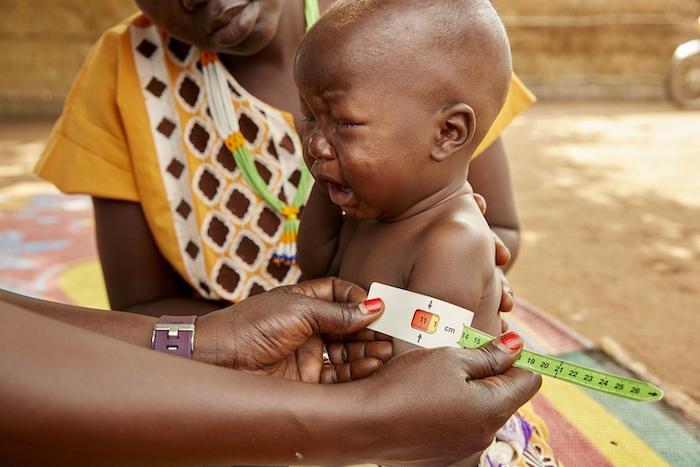
At a UNICEF-supported nutrition center in Aweil, South Sudan, 8-month-old Akot's mid-upper arm circumference (MUAC) measurement is in the red, an indication that he is suffering from severe acute malnutrition (SAM). © UNICEF/UN0344981/Wilson
Eight-month-old Akot was constantly crying and didn't want to be held by anyone except his mother. Eventually, my colleague Jesca, who is a nutritionist, won him over and was able to console him for a few minutes.
Eight-month-old Akot was constantly crying and didn't want to be held by anyone except his mother.
The videographer was frustrated as his job was to get Akot on film. After two days, he had approximately two minutes of footage where he wasn't crying. "Helene, I have no idea how we will edit this," he said, looking worried. Little did he know how much he would come to like Akot, but more on that later.
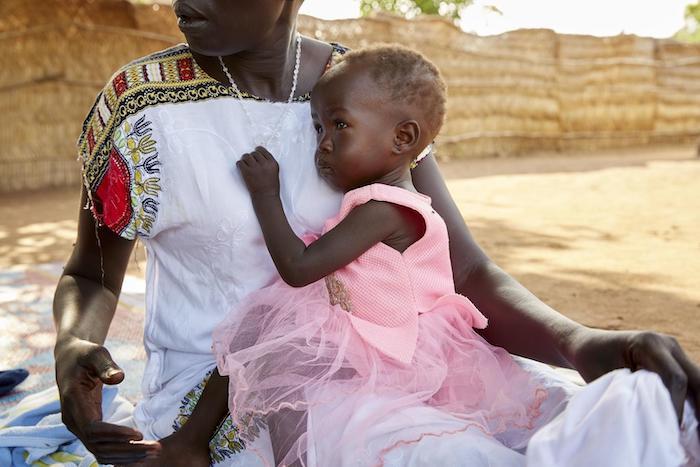
Fourteen-month-old Adut sits silently on her mother's lap at the UNICEF-supported Gabat nutrition center in Aweil, South Sudan. Sick with malaria, she developed respiratory problems, an eye infection and diarrhea, which led to severe acute malnutrition. © UNICEF/UN0344907/Wilson
Fourteen-month-old Adut was Akot's total opposite. She was quiet and fairly indifferent to everything and everyone. To get her perspective on the situation, we placed a Go-Pro camera on her head from time to time. She was fine with it, even though the camera was almost as big as her forehead.
Some are so uncomfortable they cry all the time. Others don't have the energy to show their pain.
Both Adut and Akot's behavior was quite normal for children suffering from severe acute malnutrition. Some are so uncomfortable they cry all the time. Others don't have the energy to show their pain.
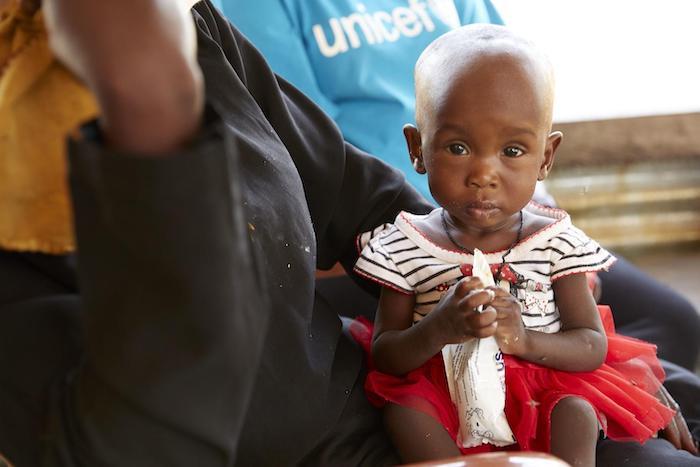
Quiet and too weak to stand, 9-month-old Amira holds a packet of Ready-to-Use Therapeutic Food (RUTF) at the UNICEF-supported Gabat nutrition center in Aweil, South Sudan. © UNICEF/UN0345092/Wilson
We spotted Amira from a distance. Even 100 feet away, we could see how her head appeared unusually large. It didn't fit her body. Her upper arms were very thin, measuring less than four inches when tested with a mid-upper arm circumference (MUAC) strip.The strip looks like a tailor's measuring tape, but it's used to screen for malnutrition.
The bad news is that an estimated 292,000 children under the age of 5 will suffer from severe acute malnutrition in South Sudan in 2020. The good news is that it is easy to treat if we can get to them early.
The bad news is that an estimated 292,000 children under the age of 5 will suffer from severe acute malnutrition in South Sudan in 2020. The good news is that it is easy to treat if we can get to them early.
Akot, Amira and Adut were all admitted to the UNICEF-supported outpatient therapeutic program in Aweil. Eight weeks later, they were all discharged from the program. I went back to see them and was shocked.
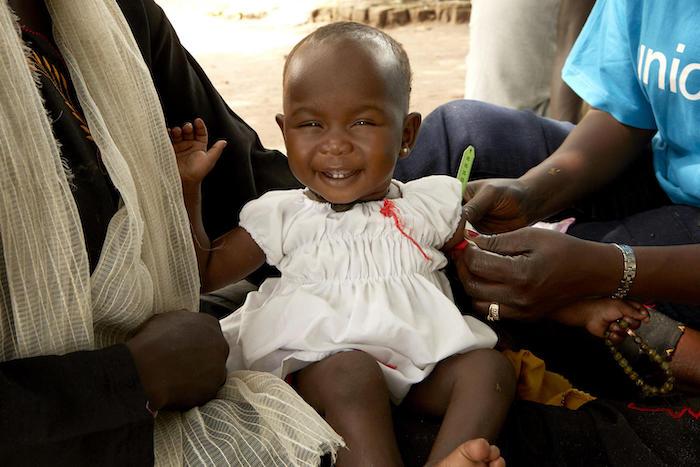
UNICEF nutritionist Jesca Wude Murye measures 11-month-old Amira's mid-upper arm circumference at Gabat nutrition center in Aweil, South Sudan. Amira is thriving after eight weeks of treatment for severe acute malnutrition. © UNICEF/UN0345146/Wilson
Physically, Amira has transformed the most. Her mid-upper arm circumference have increased from under 4 inches to almost 5 inches, and her weight has risen from under 11 pounds to over 14 pounds. I must admit I didn't recognize her at first when I returned. When we first met, she didn't have much hair. Now she is starting to grow a mane of black hair.
Akot used to refuse food, but now his ravenous appetite seems insatiable.... I caught him almost falling into a pot filled with peeled peanuts.
Akot used to refuse food, but now his ravenous appetite seems insatiable. His mother giggled when she told me that he is constantly stealing food from his siblings and I caught him almost falling into a pot filled with peeled peanuts.
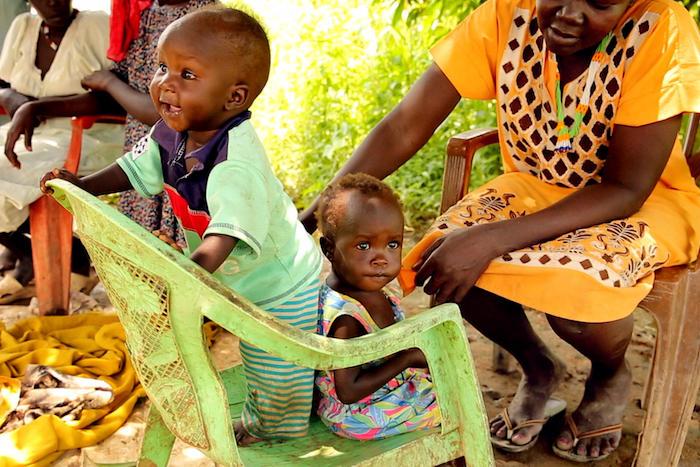
After eight weeks of treatment for severe acute malnutrition, 10-month-old Akot (left) and 16-month-old Adut are happy, busy babies in Aweil, South Sudan. © UNICEF/UNI206913/Wilson
Adut started walking during the course of the program. When she was sick, she could only take a few steps if someone was helping her, while her peers were running. Now, Adut is also running — and too fast, according to her mother, Angelina, who is trying to keep her away from the dirty rainwater ponds outside their house.
In just eight weeks, these children have been through a total body transformation. They have more fat and more muscles. The ratio between the different body parts now looks normal. Their hair has gone from greyish to black. Their skin is no longer pale.
For me, having seen the before and after, the biggest change is their behavior.
For me, having seen the before and after, the biggest change is their behavior.
Amira is very active and plays around the house. She often "helps" with the dishes — sometimes to her mother's frustration. She has started talking and she even talks back to her grandmother.
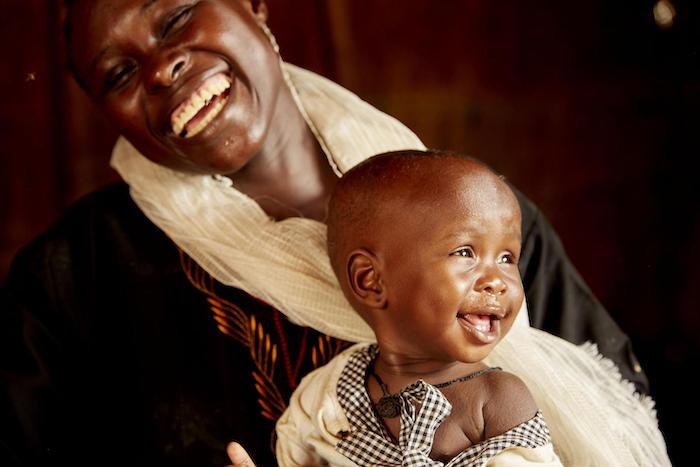
Amira's mother, Einas Ahmed Harun Mohamed Sajid, is happy now that her baby is healthy again. © UNICEF/UN0345130/Wilson
I had to look at photos from our first visit to check if Adut smiled when we met, because I couldn't remember seeing her happy. Now, I can't get the sound of her laughter out of my head. She is comfortable with strangers like me, so long as we are not boring adults but playing along.
I couldn't remember seeing [Adut] happy. Now, I can't get the sound of her laughter out of my head.
Akot is very busy crawling around at full speed, discovering everything around him. A leaf or a plastic bottle can keep him busy for long periods of time, and he only cries when he is hungry. "He is just one big smile and so easy to work with," the videographer said at the end of our last visit.
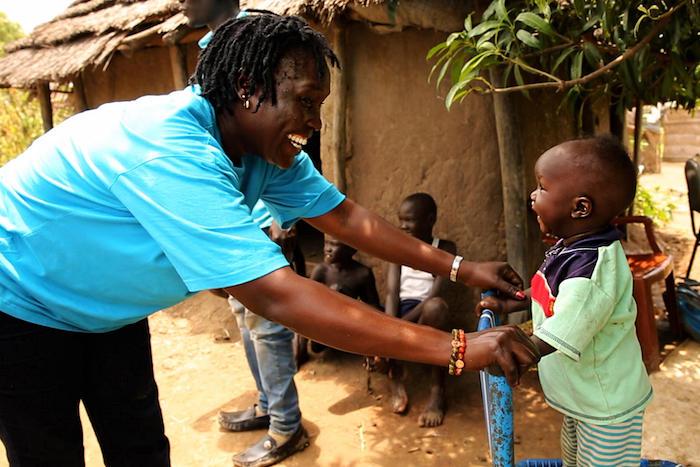
Ten-month-old Akot plays with UNICEF nutritionist Jesca Wude Murye outside Akot's home in Aweil, South Sudan. © UNICEF/UN0345047/Wilson
What a change! I have been with UNICEF for seven years and I know that UNICEF's nutrition programs work, but never have I followed cases as closely as this. And I'm stunned. Proud. And humbled at the same time. Stunned because of the big changes, proud of the work UNICEF is doing with our partners and humble because I know that these three babies might not be alive today if it wasn't for the nutrition programs.
Why are so many children not getting the healthy foods they need to grow? Read the 2019 edition of UNICEF's annual State of the World's Children report,Children, Food and Nutrition: Growing well in a changing world.
For over 70 years, UNICEF has been putting children first, working to protect their rights and provide the assistance and services they need to survie and thrive. Help UNICEF continue to improve nutrition for children.
Helene Sandbu Ryeng is a communication specialist working for UNICEF in South Sudan.
Top photo: After eight weeks of treatment for severe acute malnutrition, 14-month-old Adut plays happily with UNICEF nutritionist Jesca Wude Murye in Aweil, South Sudan. © UNICEF/UN0344938/Wilson
